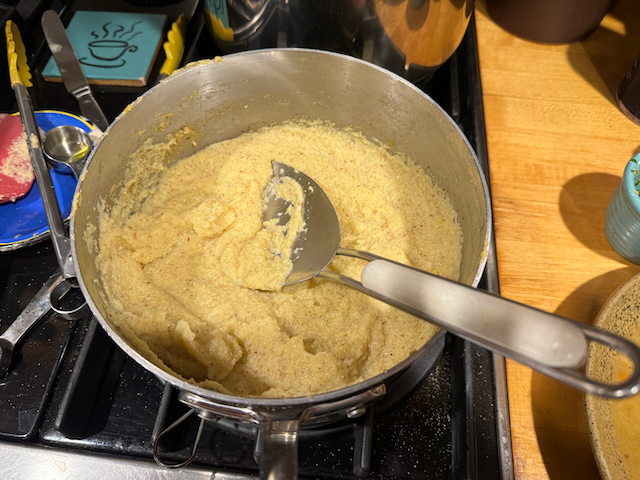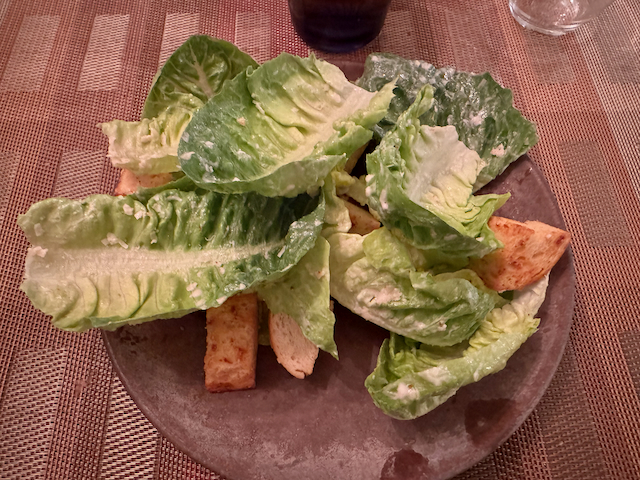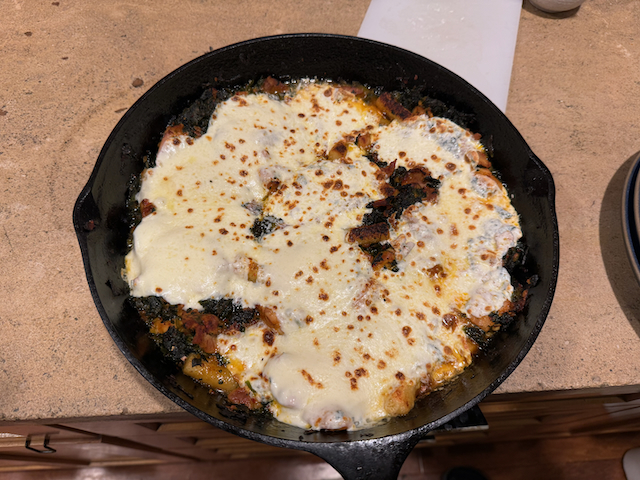We started with a Persimmon Salad! Persimmons are fantastic this year!
How to cook the perfect osso buco
The Guardian
The best-known version hails from Milan, where it is generally served with a vivid yellow saffron risotto, also made with bone marrow. Most of the recipes I try claim to be for ossibuchi alla milanese, yet they vary wildly – Anna Del Conte prefaces her take with the somewhat prickly claim that "as a loyal Milanese who strives to defend our highly sophisticated cuisine from the intrusion of foreign flavour, I can do no better than quote from the great 19th-century writer, Artusi: 'This is a dish that should be left to the Milanese.'" Well, here goes.
Meat
There is no debate here: osso buco must be made from veal shin and, preferably, as Marcella Hazan observes, that "from a calf's hind shank … the ring of meat that circles it is the sweetest and most tender on the entire animal". It is also vital to leave the skin on, or the shanks will fall apart during cooking – Hazan reckons "its creamy consistency makes a delectable contribution to the final flavour of the dish".
As you're likely to have to order this from the butcher, it shouldn't be too hard to make sure you get what you want. Ask for the pieces to be cut 4-5cm thick: any larger, and they won't cook down to the requisite melting tenderness in time; any thinner, and you risk them drying out. (Although beef shin is considerably easier to get hold of in this country, the pieces will be too large, and the flavour too strong, to substitute really satisfactorily – I'd strongly suggest hunting down British rose veal).
It is essential to start by browning it well in flour; though this should be a delicately meaty dish, a little caramelisation is rarely unwelcome, and Angela Hartnett's mere "light colouring" seems a wasted opportunity. Why Hazan does this in a separate pan is unclear; not only does it multiply the washing up, but you risk losing some of that flavour when you transfer the meat.
Vegetables
Few surprises here: like many Italian dishes, this starts with a sofrito – the slow-cooked holy trinity of onions, celery and carrot also known as a mirepoix or simply a soup base. Del Conte leaves out the carrot, possibly because it disrupts the "bianco" nature of her recipe, but I like the sweetness it adds, so I'm going for the lot, though the red onion in the River Café Classic Italian Cookbookproves a little too much.
Interestingly, Lindsey Bareham and Simon Hopkinson's recipe in the Prawn Cocktail Years eschews vegetable matter altogether, in favour of a pared-back osso buco which is just a little too simple for my liking. Along with their intense, syrupy sauce, it's more like meat with a jus than the almost stew-like results produced by the other recipes.
Hartnett also adds leeks, which end up a little bit slimy after three hours of cooking, plus a whole head of garlic. Hazan uses a mere finely chopped teaspoon, and everyone else rejects garlic entirely, but because Hartnett uses it whole, essentially braising it in its skin, it lends a wonderful caramelised sweetness to the dish. It may not be canonical, but it's going into my osso buco nevertheless.
Sauce
White wine is a must in an osso buco. You can reduce it entirely, as the Silver Spoon suggests, but leaving some in the sauce, as most other recipes do, gives a far lighter, zingier result. Bareham and Hopkinson leave it at that, with just the juice of a lemon as seasoning. I find their version too acidic – though it must be said, it does cut through the richness of the marrow nicely, if you happen to think it needs cutting through.
Everyone else uses stock of some kind. Meat stock, made from beef and veal, is the most common, although Hartnett goes for chicken. If you're not going to go to the trouble of making your own (and, let's be realistic here, you'll need to source the bones and start a day ahead), Hartnett's is a much better choice than bought beef stock – however good the quality, it's overpoweringly beefy. Chicken stock tastes more elegant.
The great tomato debate
Del Conte, who, as we've established, feels strongly about the preservation of the "authentic milanese osso buco" (as she calls her version), reckons one of the defining characteristics is that "it is cooked in bianco, without tomato". (She explains that "the flavour of a gremolata would be swamped by a tomato-based sauce … and [a] delicate saffron-based risotto could not survive alongside an osso buco with a strong tomato flavour.") Her recipe, then, contains no tomato whatsoever – and neither does Bareham and Hopkinson's, though they make no claims for its Milanese credentials.
Everyone else sticks in tomatoes: fresh in Hartnett's case, puree in the Silver Spoon recipe and tinned for Hazan. The tomato puree, plus meat stock, makes the Silver Spoon's version too intensely savoury; a risotto would stand no chance against its thick gravy. The fresh and tinned varieties are more successful; in fact, both dishes are delicious, but lack the delicately meaty, buttery flavour of Del Conte's triumph of a recipe. Whatever the true history of the matter, there are enough tomato-based dishes in the Italian repertoire; this one doesn't need them.
Flavourings
It is also not a dish that demands much in the way of herbs and spices. Hazan and Hartnett use thyme, which I find a bit strident, and Hazan's parsley disappears without trace. Bareham and Hopkinson are very laissez-fare – "rosemary or sage or marjoram – please yourself", so I do, and find that sage works very well indeed with the buttery sauce. Del Conte writes that an authentic Milanese ossobuco is flavoured with lemon rind, by which she seems to mean the accompanying gremolata. I like Hazan's idea of adding a couple of strips to the dish as it cooks, though; it adds a delicate zestiness to proceedings.
Cooking
The Silver Spoon simmers its osso buco for a mere half hour, while Hartnett recommends two to threee. I find my veal has slightly dried out by the third hour; depending on the thickness of your pieces, an hour and a half to two should be quite sufficient. Hazan bakes her version, rather than simmering it on the hob. I've often found this to be easier for long, slow cooking, but as she puts it in at 180C, I'm not quite sure why she bothers.
Del Conte finishes her dish with a little butter, "to give the sauce a glossy shine and a delicate taste". Though it doesn't need the extra fat, as with so much else in life, it certainly doesn't hurt. Last of all, I'd like to pass on Hartnett's wise words: "I like to encourage people to eat this with their fingers – so much easier than fiddling about with a knife and fork!". Napkins advisable.
The perfect osso buco
(Serves 4)
2 tbsp olive oil
25g flour, to dust
4 pieces of veal shin, about 4cm thick
50 g butter
1 onion, finely chopped
1 carrot, finely chopped
1 celery stick, finely chopped
1 head of garlic, cut horizontally
2 strips of lemon zest
4 sage leaves
200ml white wine
200ml good chicken stock
FOR THE GREMOLATA
1 unwaxed lemon, zest finely grated
1 garlic clove, very finely chopped
3 tbsp flat-leaf parsley, finely chopped
Pinch of sea salt
Set a casserole dish wide enough to hold the meat in one layer over a high heat, and add the oil. Put the flour on to a small plate and season generously, then use to coat the meat. When the oil is hot, add the meat to the pan and brown well on both sides until golden and crusted. Set aside on a plate.
Turn the heat down and add three quarters of the butter to the pan. When melted, add the onion, carrot and celery, plus a sprinkle of salt, and cook until soft. Add the garlic halves, lemon zest and sage to the pan and cook for a few minutes more.
Turn up the heat then add the wine to the pan. Return the meat, standing it on top of the vegetables, and bubble until the wine has reduced by half. Pour in the stock and bring to a simmer.
Turn the heat right down, cover and simmer for one and a half to two hours, carefully turning the meat over every 30 minutes, until it is tender enough to cut with a spoon. Meanwhile, mix together the gremolata ingredients.
Dot with the remaining butter and allow to melt into the sauce, then serve with the gremolata and risotto alla milanese or wet polenta.





















